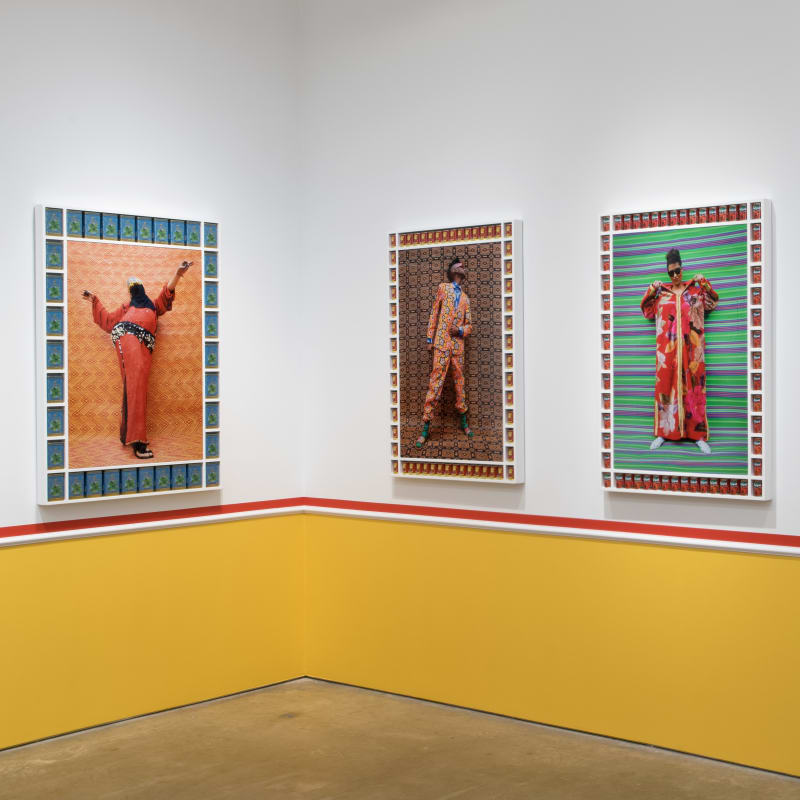JTF (just the facts): A total of 33 color photographs in custom artist's frames, displayed against white walls with green and yellow accents/moldings in the East and West gallery spaces as well as the smaller viewing room in between. All of the works are metallic Lambda prints on Dibond, in spray-painted white frames surrounded by a variety of tins, cans, and pop culture items. Physical image sizes range from roughly 29×19 to 41×59 inches, with most works at 44×30 inches; editions range from 3+2AP to 10+2AP based on size, with most at 5+2AP.
The show also includes installations of Coca-Cola crates with bamboo printed seat cushions (around the poles in the main galleries) and Louis Vuitton cushions (in the viewing room).
Comments/Context: With our first tentative steps out of collective pandemic hibernation, the broader availability of vaccines, and the intermittent return of warmer Spring weather, it's possible to feel a tiny hint of forward thinking optimism in the air in New York. And with its contagious, ebullient positivity, this show of Hassan Hajjaj's work feels well timed to meet, and amplify, our slowly improving mood.
In the past decade or so, Hajjaj has carved out a unique position in contemporary photography by smartly taking aesthetic lessons from several different strands of photographic history, drawing them through the rich culture of Morocco and North Africa, and boldly remixing them into his own immediately identifiable signature look. The result is a growing body of portraiture that feels modern, upbeat, and wholly original, that embraces us with its inclusiveness and high-spirited energy.
The My Rockstars series gathers together portraits of musicians, artists, actors, dancers, writers, activists, and other performers, from the US, the UK, and around North Africa and the Middle East. Cardi B, Hank Willis Thomas, Riz Ahmed, and Lynette Yiadom-Boakye may be familiar to some, but Hajjaj's firmament is filled with both the known and unknown, celebrating performative excellence (and outsized personalities) in many forms.
His portraits generally use a standard compositional template: the sitter, dressed in brightly colored clothes provided by the artist, poses either standing or sitting on a plastic crate (like the ones in the gallery), in a few cases with an instrument or other prop, surrounded by patterned fabrics as backdrops and floor coverings. (A handful of the works on view also come from the series 'Kesh Angels (2014 gallery show reviewed here), where women were posed sitting on motorcycles.) Each print is then housed in a custom wood frame that has individual niches that surround the edges of the image and are filled with colorful cans, tins, and other containers.
Hajjaj's aesthetic debts to the pioneers of African studio portraiture, like Seydou Keïta and Malick Sidibé, are clear. He has learned from their sophisticated use of pattern, from their modes of aspirational identity creation, and even from some of their poses, taking these compositional lessons and supercharging them for a new age. Hajjaj's backdrop and floor patterns go far beyond the elegant simplicity of black and white stripes or checkerboards, bursting into full, enveloping colors (most drawn from local textiles and plastic mats) that vibrate with saturated vitality. Hajjaj generally opts for close cropping, keeping his sitters tightly bound by these patterns of stars, stripes, spots, and other more elaborate decorative geometrics, ensuring that the liveliness of these designs helps animate the moment.
Hajjaj has also absorbed the idea of studio portraiture as a malleable vehicle for identity definition. Back in the 1960s, everyday sitters held up record covers, posed with telephones, and wore funky sunglasses in an attempt to be hip and modern. In Hajjaj's case, most of his subjects are already plenty self-confident, but he encourages their swaggers, struts, and showing off, celebrating the process of stepping out and being seen. Most of Hajjaj's sitters wear hand-crafted clothes that the artist has designed, his suits, hats, and shoes repurposing local textiles into dapper costumes that echo the patterned surroundings of the shoot. In many cases, Hajjaj deliberately mixes high fashion and low culture, exaggerating the intermingling of the streets and the runway in ways that feel fresh and open.
This deliberate juxtaposition also comes though in Hajjaj's innovative use of everyday objects as a framing device. Each portrait is housed in a custom frame with slots that have been filled with tea tins, canned vegetables (like tomatoes, olives, and peppers), plastic vegetable forms, and even multi-colored toy blocks with Arabic lettering. These items strongly connect back to the local life (creating a deeper cultural context), while also providing bold lettering and color options for Hajjaj to play with. The connection to Pop Art is obvious, but again, Hajjaj's art historical awareness feels natural and unassuming, and his reuse of these motifs in resonant new ways is inspired and original.
The global hybridity of Hajjaj's works is what makes them so contemporary - he's freely reshuffling influences and cultural signifiers, and showing us a world where individuals happily draw from all kinds of sources to define who they are. The resulting dynamism isn't just a result of an acrobatic hand stand, an energetic inverted kick, or a sultry hip thrust - it comes from Hajjaj's ability to make his sitters feel comfortable with their bold and beautiful authenticity.
By redirecting the staginess of fashion photography into amplifying personalities, the pictures feel sharp, but also quietly supportive and affirmative. These photographs are filled with playful contradictions and over-the-top dissonance, to be sure. But their positive spirit is more than just surface excitement and colorful decoration - Hajjaj is expanding the edges of how a 21st century photographic portrait can succeed, looking for unexpected ways to bring together layers of complex individuality that don't normally fall neatly into line.

